Subaru Forester: Rear seats
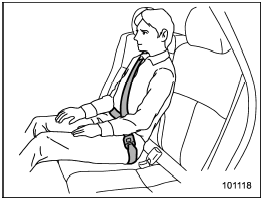

Seatbelts provide maximum restraint when the occupant sits well back and upright in the seat. Do not put cushions or any other materials between occupants and seatbacks or seat cushions. If you do so, the risk of sliding under the lap belt and of the lap belt sliding up over the abdomen will increase, and both can result in serious internal injury or death.
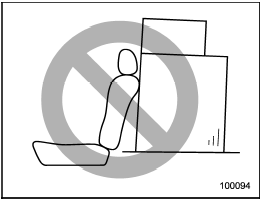

Never stack luggage or other cargo higher than the top of the seatback because it could tumble forward and injure passengers in the event of a sudden stop or accident.
Armrest
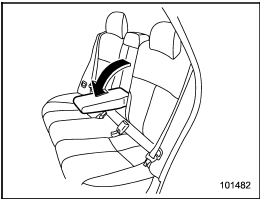
Armrest
To lower the armrest, pull on the top edge of the armrest.

To avoid the possibility of serious injury, passengers must never be allowed to sit on the center armrest while the vehicle is in motion.
Head restraint adjustment
Both the rear window side seats and the rear center seat are equipped with head restraints.

- Never drive the vehicle with the head restraints removed because they are designed to reduce the risk of serious neck injury in the event that the vehicle is struck from the rear. Therefore, when you remove the head restraints, you must reinstall all head restraints to protect vehicle occupants.
- All occupants, including the driver, should not operate a vehicle or sit in a vehicle’s seat until the head restraints are placed in their proper positions in order to minimize the risk of neck injury in the event of a crash.
Rear windows side seating position
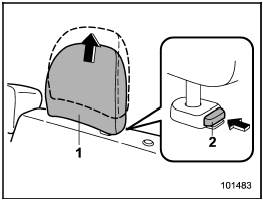
Rear windows side seating position
1) Head restraint
2) Release button
To remove:
While pressing the release button, pull out the head restraint.
To install:
Install the head restraint into the holes that are located on the top of the seatback until the head restraint locks.
Rear center seating position

The head restraint is not intended to be used at the lowest position.
Before sitting on the seat, raise the head restraint to an appropriate position depending on your sitting height.
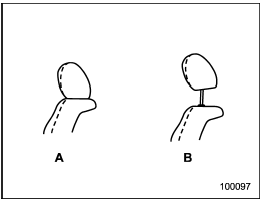
A) When not used (retracted position)
B) When used (click position)
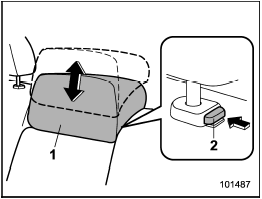
1) Head restraint
2) Release button
To raise:
Pull the head restraint up.
To lower:
Push the head restraint down while
pressing the release button on the top of
the seatback.
To remove:
While pressing the release button, pull out
the head restraint.
To install:
Install the head restraint into the holes that
are located on the top of the seatback until
the head restraint locks.
When the rear-center seating position is occupied, raise the head restraint to an appropriate position depending on your sitting height. When the rear center seating position is not occupied, lower the head restraint to improve rearward visibility.
Reclining the seatback (if equipped)


To prevent the passenger from sliding under the seatbelt in the event of a collision, always put the seatback in the upright position while the vehicle is in motion. Also, do not place objects such as cushions between the passenger and the seatback. If you do so, the risk of sliding under the lap belt and of the lap belt sliding up over the abdomen will increase, and both can result in serious internal injury or death.

If the vehicle is equipped with a cargo area cover, observe the following precautions.
- Be careful not to pinch your hand between the headrest and the cargo area cover when you recline the rear seat.
- Move the front cover of the cargo area cover backward so that the cover is not damaged by the reclined seatback. Refer to “Cargo area cover (dealer option)”.
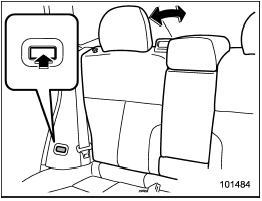
Push the switch and adjust the seatback to the desired position.
Then release the switch and make sure the seatback is securely locked into place.
Folding down the rear seatback

- When you fold down the seatback, confirm that there are no passengers or objects on the rear seat. Not doing so creates a risk of injury or property damage if the seatback suddenly folds down.
- For models equipped with the rear seat center table, when folding down the rear seatback, return the rear seat center table to its original position. If the rear seat center table is not returned to its original position, the rear seat center table could break and bodily injury could occur.
- Never allow passengers to ride on the folded rear seatback or in the cargo area. Doing so may result in serious injury or death.
- Secure all objects and especially long items properly to prevent them from being thrown around inside the vehicle and causing serious injury during a sudden stop, a sudden steering maneuver or a rapid acceleration.
- When you return the seatback to the original position, shake the seatback slightly to confirm that it is securely fixed in place. If the seatback is not securely fixed in place, the seatback may suddenly fold down because of sudden braking or objects may move out from the cargo area, which could cause serious injury or death.
- After returning the rear seatback to its original position, be certain to place all of the seatbelts and the tab attached to the seat cushion above the seat cushion.
And make certain that the shoulder belts are fully visible.

For models with the reclining function, the rear seatback may automatically and forcefully fold down because of its internal spring. Place your hand on the seatback to lower it more gradually.
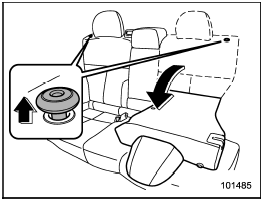
Release knob
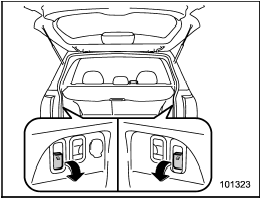
One-touch seatback folding lever (if equipped)
1. Lower the head restraints.
2. Unlock the seatback by pulling the release knob or the one-touch seatback folding lever, and then fold the seatback down.
To return the seatback to its original position, raise the seatback until it locks into place and make sure that it is securely locked.
See also:
Gauges
Speedometer The speedometer indicates the forward speed of the vehicle. Tachometer
The tachometer indicates the approximate number of engine revolutions per minute
(rpm). Use the tachometer to select the correct shift points and to prevent luggin ...
Flat tires
If you have a flat tire while driving, never
brake suddenly; keep driving straight
ahead while gradually reducing speed.
Then slowly pull off the road to a safe
place. ...

 Front seats
Front seats